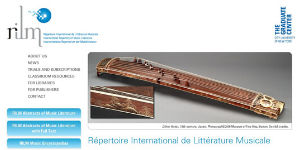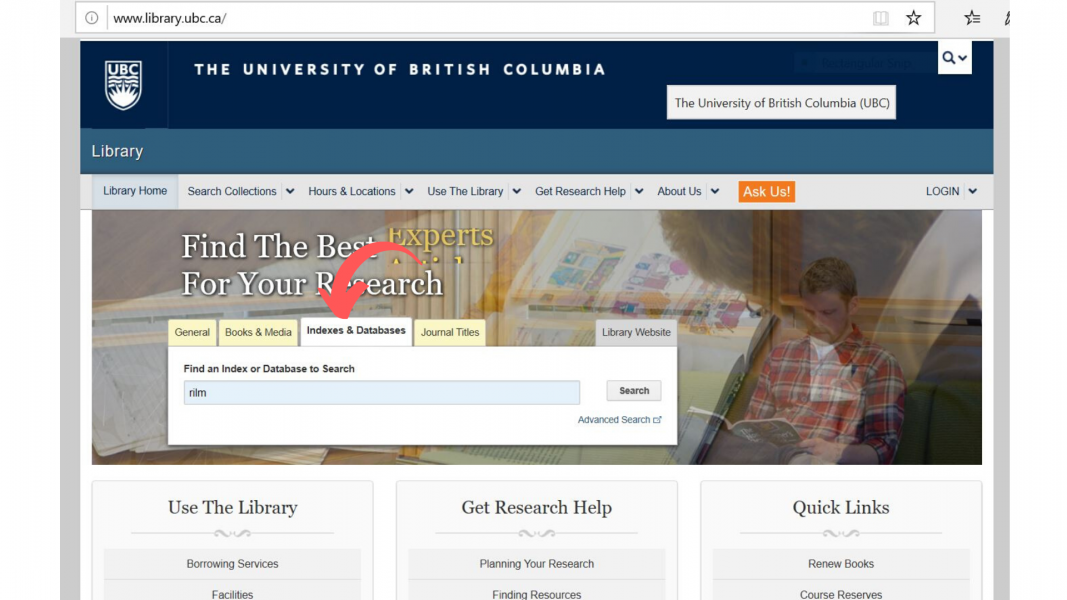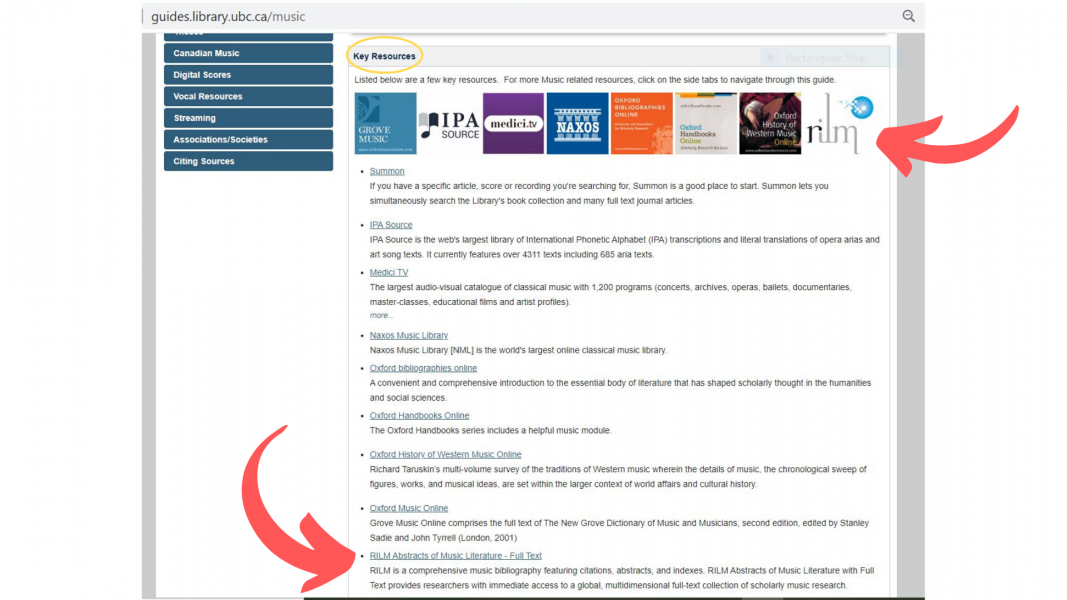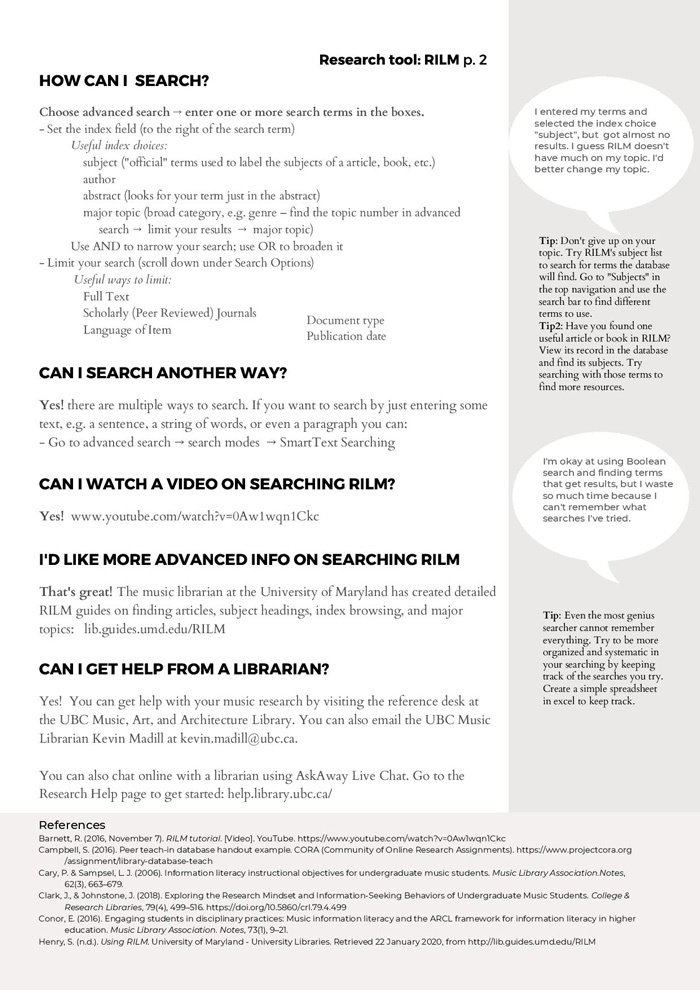I geared my lesson on RILM (Répertoire International de Littérature Musicale) towards a specific audience, undergraduate music students, and set it up as if I were teaching to a 300 level required class where students had to do a major research paper on music. A large part of my lesson was activity-based, culminating in the students peer teaching each other.
Menu
Lesson on RILM
Class: MUS 320 Introduction to Musicology & Music Research
Assignment: Major Music Research Project
Research tool: RILM
Today: RILM How & Why
What is RILM?
THE online database for (most) music research
→ contains citations and abstracts & access to full-text materials
- RILM can help you find WAY more relevant, varied, and high-quality resources on music than The Music Index database or just searching online (Google, etc).
What is RILM for?
Use RILM to:
- Find scholarly articles, books, conference proceedings, etc.
- Find concert reviews, recording notes, pedagogical manuals, etc.
- Find articles, books etc, in English and MANY other languages
- Explore research on music
- Discover many different approaches to studying music
- Focus your research topic
- Do a literature review
- Pass MUS 320!
Don’t use RILM to:
- Look up a fact
- Find a recording
- Find a musical score
- Find a musician’s biography
Activity
(I made sure students were grouped into four groups and assigned each group a name: Group Red, Group Gold, Group Blue, and Group Purple. I gave each group their activity handout and introduced what they will do at each step - explore, learn, peer teach.
* NOTE: Each team's activity sheet has a different research project topic idea, and different search tasks. **Also, the research project topic ideas are taken from the students' proposed research topics.)
Activity handouts
Group Purple's handout, as an example:
Peer Teach
After the teams finished the explore and learn sections of the activity, they transitioned to the peer teach section. I used this diagram to help students seamlessly move to the correct table to begin their peer teaching:
Why RILM?
- RILM can help you do research that isn’t just about satisfying your personal curiosity on some music you like.
- RILM can help you do research that contributes to ongoing debates on music → you can be part of scholarly conversation.
☆ Don’t forget: A component of your research project is a contribution statement →
You must explain how your project represents a contribution to the field of music research.
Questions you will have to answer:
- How does your research question engage with the works cited in your literature review?
- How does your research question fit within the existing debates you encountered during your literature review?
TIP: If you don’t use RILM, there is a 99% chance you will not be able to answer these questions properly.
Open and read the activity handouts, RILM guide handout, and list of references 
References
Association of College & Research Libraries. (2019). Characteristics of programs of information literacy that illustrate best practices: A guideline. Retrieved 7 February 2020, from
http://www.ala.org/acrl/standards/characteristics
Barnett, R. (2016, November 7). RILM tutorial. [Video]. YouTube.
https://www.youtube.com/watch?v=0Aw1wqn1Ckc
Campbell, S. (2016). Peer teach-in database handout example. CORA (Community of Online Research Assignments). https://www.projectcora.org/assignment/library-database-teach
Cary, P., & Sampsel, L. J. (2006). Information literacy instructional objectives for undergraduate music students. Music Library Association.Notes, 62(3), 663–679.
Clark, J., & Johnstone, J. (2018). Exploring the research mindset and information-seeking behaviors of undergraduate music students. College & Research Libraries, 79(4), 499–516.
https://doi.org/10.5860/crl.79.4.499
Conor, E. (2016). Engaging students in disciplinary practices: Music information literacy and the ARCL framework for information literacy in higher education. Music Library Association.
Notes, 73(1), 9–21.
Duffy, M. J. (2018). Contemporary analysis of information literacy in music: A literature review and selected annotated bibliography. Music Reference Services Quarterly, 21(2), 45–77.
https://doi.org/10.1080/10588167.2017.1398801
Froehlich, H., & Frierson-Campbell, C. (2012). Inquiry in music education: Concepts and methods for the beginning researcher. Routledge. https://ebookcentral.proquest.com/lib/ubc/detail.action?docID=1024673
Henry, S. (2018). Using RILM. University of Maryland - University Libraries. Retrieved 22 January 2020, from http://lib.guides.umd.edu/RILM

Related Activity: Music Library & Diversity: Topic Briefing









